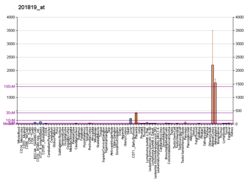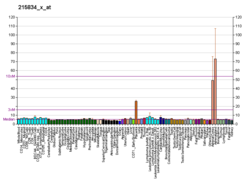| SCARB1 |
|---|
|
| Identifiants |
|---|
| Aliases | SCARB1 |
|---|
| IDs externes | OMIM: 601040 MGI: 893578 HomoloGene: 21132 GeneCards: SCARB1 |
|---|
| Position du gène (Homme) |
|---|
 | | Chr. | Chromosome 12 humain[1] |
|---|
| | Locus | 12q24.31 | Début | 124,776,856 bp[1] |
|---|
| Fin | 124,882,668 bp[1] |
|---|
|
| Position du gène (Souris) |
|---|
 | | Chr. | Chromosome 5 (souris)[2] |
|---|
| | Locus | 5 64.11 cM|5 G1.1 | Début | 125,354,151 bp[2] |
|---|
| Fin | 125,418,158 bp[2] |
|---|
|
| Expression génétique |
|---|
| Bgee | | Humain | Souris (orthologue) |
|---|
| Fortement exprimé dans | - right adrenal cortex
- left adrenal gland
- left adrenal cortex
- right lobe of liver
- left ovary
- right ovary
- putamen
- noyau caudé
- subcutaneous adipose tissue
- placenta
|
| | Fortement exprimé dans | - glande surrénale
- cumulus cell
- épithélium pigmentaire rétinien
- crête génitale
- artère carotide externe
- artère carotide interne
- neural layer of retina
- lactiferous gland
- Vésicule vitelline
- corps ciliaire
|
| | Plus de données d'expression de référence |
|
|---|
| BioGPS | 
 | | Plus de données d'expression de référence |
|
|---|
|
| Gene Ontology |
|---|
| Fonction moléculaire | - apolipoprotein binding
- protein homodimerization activity
- virus receptor activity
- transporter activity
- high-density lipoprotein particle receptor activity
- phosphatidylserine binding
- apolipoprotein A-I binding
- lipopolysaccharide binding
- low-density lipoprotein particle binding
- 1-phosphatidylinositol binding
- liaison protéique
- high-density lipoprotein particle binding
- lipopolysaccharide immune receptor activity
- amyloid-beta binding
- scavenger receptor activity
| | Composant cellulaire | - cytoplasme
- integral component of membrane
- endocytic vesicle membrane
- intracellular membrane-bounded organelle
- membrane
- membrane plasmique
- integral component of plasma membrane
- surface cellulaire
- lysosomal membrane
- Cavéole
- exosome
- microvillus membrane
| | Processus biologique | - cholesterol import
- positive regulation of triglyceride biosynthetic process
- regulation of phosphatidylcholine catabolic process
- recognition of apoptotic cell
- lipid transport
- low-density lipoprotein particle clearance
- blood vessel endothelial cell migration
- positive regulation of cholesterol storage
- phospholipid transport
- cholesterol transport
- cicatrisation
- cholesterol catabolic process
- endocytose à récepteur
- high-density lipoprotein particle remodeling
- positive regulation of endothelial cell migration
- androgen biosynthetic process
- vitamin transmembrane transport
- positive regulation of nitric-oxide synthase activity
- endothelial cell proliferation
- lipopolysaccharide transport
- cholesterol efflux
- phagocytosis, recognition
- pénétration virale
- absorption intestinale
- cholesterol homeostasis
- regulation of phagocytosis
- adhesion of symbiont to host
- viral process
- detection of lipopolysaccharide
- triglyceride homeostasis
- reverse cholesterol transport
- lipopolysaccharide-mediated signaling pathway
- high-density lipoprotein particle clearance
| | Sources:Amigo / QuickGO |
|
| Orthologues |
|---|
| Espèces | Homme | Souris |
|---|
| Entrez | | |
|---|
| Ensembl | | |
|---|
| UniProt | | |
|---|
| RefSeq (mRNA) | | |
|---|
NM_001205082
NM_001205083
NM_016741 |
|
|---|
| RefSeq (protéine) | NP_001076428
NP_005496
NP_001354910
NP_001354911
NP_001354912
|
|---|
NP_001354913
NP_001354914
NP_001354915
NP_001354916
NP_001354917
NP_001354918 |
| |
|---|
NP_001192011
NP_001192012
NP_058021 |
|
|---|
| Localisation (UCSC) | Chr 12: 124.78 – 124.88 Mb | Chr 5: 125.35 – 125.42 Mb |
|---|
| Publication PubMed | [3] | [4] |
|---|
|
| Wikidata |
| Voir/Editer Humain | Voir/Editer Souris |
|
Le SCARB1 (pour « Scavenger receptor class B type 1 »), ou SR-BI, est une protéine impliqué dans le métabolisme du cholestérol. Son gène est SCARB1 situé sur le chromosome 12 humain.
Rôles
Il s'agit d'un récepteur au HDL cholestérol situé principalement au niveau du foie[5], permettant l'élimination de ce dernier et le relargage du cholestérol dans la bile[6].
En médecine
La mutation du gène entraîne une augmentation du taux sanguin du HDL-cholestérol[7] mais sans modification du risque de maladie cardio-vasculaire[8].
Notes et références
- ↑ a b et c GRCh38: Ensembl release 89: ENSG00000073060 - Ensembl, May 2017
- ↑ a b et c GRCm38: Ensembl release 89: ENSMUSG00000037936 - Ensembl, May 2017
- ↑ « Publications PubMed pour l'Homme », sur National Center for Biotechnology Information, U.S. National Library of Medicine
- ↑ « Publications PubMed pour la Souris », sur National Center for Biotechnology Information, U.S. National Library of Medicine
- ↑ Acton S, Rigotti A, Landschulz KT, Xu S, Hobbs HH, Krieger M, Identification of scavenger receptor SR-BI as a high density lipoprotein receptor, Science, 1996;271:518–520
- ↑ Kozarsky KF, Donahee MH, Rigotti A, Iqbal SN, Edelman ER, Krieger M, Overexpression of the HDL receptor SR-BI alters plasma HDL and bile cholesterol levels, Nature, 1997;387:414–417
- ↑ Vergeer M, Korporaal SJA, Franssen R et al. Genetic variant of the scavenger receptor BI in humans, N Engl J Med, 2011;364:136–145
- ↑ Helgadottir A, Sulem P, Thorgeirsson G et al. Rare SCARB1 mutations associate with high-density lipoprotein cholesterol but not with coronary artery disease, Europ Heart J, 2018;39:2179–2182
 Portail de la biologie cellulaire et moléculaire
Portail de la biologie cellulaire et moléculaire  Portail de la médecine
Portail de la médecine
 Portail de la biologie cellulaire et moléculaire
Portail de la biologie cellulaire et moléculaire  Portail de la médecine
Portail de la médecine 




















 SCARB1
SCARB1